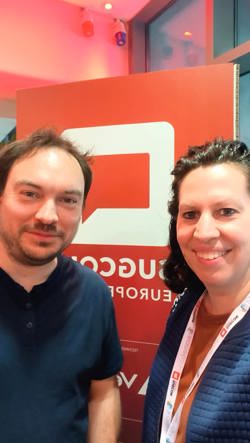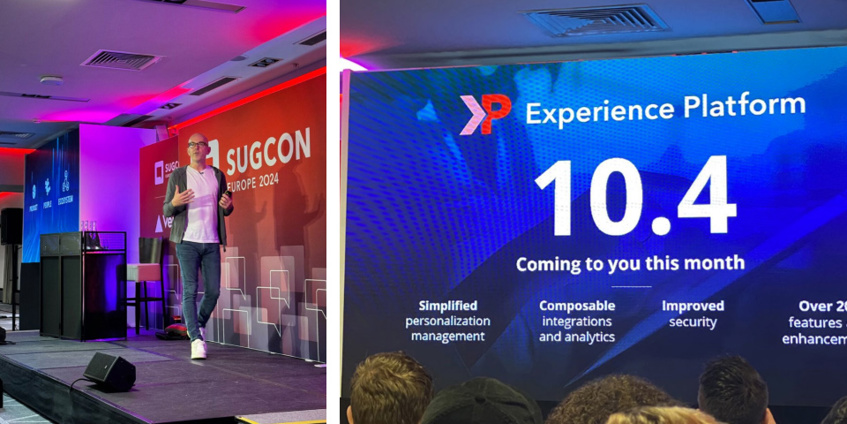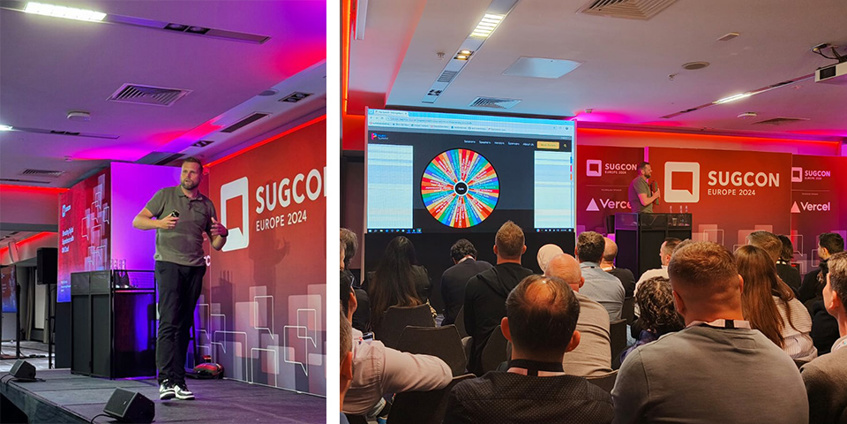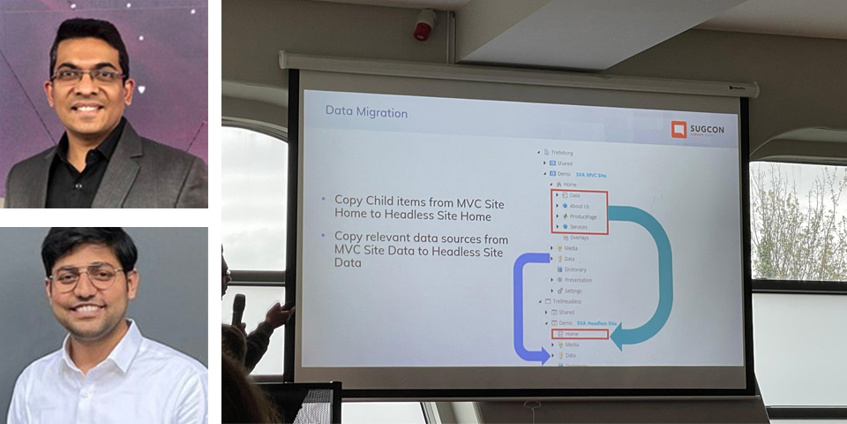SUGCON 2024 highlights
By Nele Debrouwer and Tim Vermaelen, 18-07-2024
Welcome to Dublin, a city rich in history, culture, and vibrant energy. Recently, we had the pleasure of attending the 10th version of Sitecore SUGCON Europe at the iconic Croke Park Stadium, one of Dublin's most renowned landmarks. Known for its passionate embrace of sports, music, and events, Croke Park provided an inspiring backdrop for the conference. Dublin itself offers a unique blend of old-world charm and modern innovation, making it the perfect setting for the event. From its historic streets and lively pubs to its warm and welcoming people, Dublin truly encapsulates the spirit of creativity and collaboration.
While we were only able to attend some of the sessions, the experience was nothing short of enlightening. This article provides a brief summary of the key sessions, insights, and innovations presented at SUGCON 2024. Whether you were able to attend or are catching up on what you missed, this overview is designed to give you an understanding of the event’s highlights and takeaways. By reading this, you'll gain insights into the latest trends and developments in the Sitecore ecosystem, discover practical tips and strategies from industry experts, and understand how these can be applied to enhance your digital experience projects.

Sessions
Over the course of two days, we attended several intriguing sessions. The event was inaugurated by the new CEO, Dave O’Flanagan, who announced a significant shift in Sitecore's standpoint. Sitecore is committing to enhancing its existing DXP Platform over the coming years. Last month, they released version 10.4, which focuses on simplified personalization management, composable integrations and analytics, improved security, and over 200 new features and enhancements. We go more into the details right here.

An insightful analogy was drawn between the monolithic versus composable approach, comparing it to the shift from fossil fuel cars to electric vehicles. While many people are transitioning to electric vehicles as the future, there are still many who prefer their current internal combustion engine cars, and that's perfectly fine.
The roadmap includes a better user experience for marketers, improved digital experiences for developers, and more composable integrations. This means that tools available in the composable world for XM Cloud will also be integrated into the DXP platform.
Elevating Digital Experiences with XM Cloud in the DXP Landscape
During the event, Pieter Brinkman, Vice President of Product Marketing & Developer Relations, delivered an engaging live coding session. He demonstrated the capabilities of XM Cloud through a practical example involving the creation of a basic landing page. The session included steps to create a form, utilize a QR plugin, add minor validation, and create a web hook using Sitecore Connect. Additionally, he showcased how to leverage OpenAI assistance to enhance workflows, create an email list using Sitecore Send, and set up a campaign.

To make the demonstration even more interactive, he used a free React-based wheel of fortune from GitHub, tying the entire process together as a raffle giveaway. This keynote served as a gateway to valuable insights into the CMS industry, highlighting the power and flexibility of Sitecore’s composable architecture.
Journey to the Other Side: Transitioning to Sitecore Nextjs Framework
Jeroen Speldekamp and Frank van Rooijen delivered an insightful session about their take on the monorepo system. This session was a goldmine of information for developers and architects keen on embracing new technologies, especially within the Sitecore ecosystem.
Jeroen and Frank, both seasoned professionals in the Sitecore domain, shared their practical experiences and architectural vision for transitioning to the Sitecore Next.js framework. Their talk highlighted the myriad benefits and considerations involved in moving to this modern framework, offering attendees a comprehensive guide to navigate this transition.
They explained how the framework allows for a more flexible, scalable, and performance-oriented approach compared to traditional Sitecore setups. This is particularly beneficial for developers aiming to create large component-based solutions that work well for large projects or even from a corporate point of view where re-usability is the key concept.
Jeroen and Frank detailed their journey, sharing the challenges they faced and the solutions they implemented. The people in the room took a lot of pictures of the presented package.json files in the hopes of mastering one day this stunning solution. Whether you are just beginning to consider this transition or are already in the midst of it, the insights shared by Jeroen and Frank will undoubtedly prove invaluable.
Get in touch
Ready to take your digital experience to the next level? Feel free to contact us to learn more about our services and how we can help you leverage the full potential of your digital marketing.
Seamless Evolution: Transitioning from SXA to the Headless SXA
Sreesh Maroli and Nadeem Baksh presented their solution on transitioning to a headless Sitecore SXA environment. Their approach highlighted the benefits of reusing existing functionality and enhancing external tools, all while ensuring a seamless and gradual migration.
The team operated a single Sitecore 9 instance that hosted nine subsites and four microsites under one tenant. Their goals were ambitious:
- Revamping the UI: To modernize and enhance user interaction.
- Establishing a Component Library: For consistency and reusability across all applications.
- Implementing Headless Architecture: To improve flexibility and future-proof their infrastructure..
- Enhancing Content Reusability: To streamline content management and delivery across multiple channels.

Sreesh and Nadeem chose to avoid a disruptive big bang implementation. Instead, they opted for a seamless, step-by-step transition. They created a headless SXA tenant with a shared site to facilitate this gradual migration from their existing MVC site to the new headless environment.
Central to their strategy was a PowerShell script designed to automate and streamline the migration process. The script's functions included:
- Cleaning Up the Headless Site: Preparing the environment for migration.
- Migrating Items, Data Sources, and Renderings: Efficiently transferring all necessary components from the MVC site to the headless sites.
- Leveraging OOTB ‘Clone Site’ Functionality: Utilizing Sitecore SXA's out-of-the-box features as the foundation for the script.
One of the most challenging aspects was migrating the presentation details. The PowerShell script addressed this by mapping:
- Rendering IDs
- Placeholders
- Rendering Variants
These elements were mapped from the MVC renderings to the headless renderings, ensuring a smooth and accurate transition.
This strategic approach provided numerous benefits:
- Reusability of Functionality: By leveraging existing SXA features, the team could reuse much of the functionality, saving time and resources.
- Improvement of External Tools: The new headless architecture allowed for significant enhancements to external tools, resulting in a more flexible and robust environment.
- Content Reusability: Improved content reuse across channels increased efficiency and consistency in content delivery.
- Seamless Transition: The phased approach ensured minimal disruption, allowing for a smooth and controlled transition.
Sreesh Maroli and Nadeem Baksh's presentation showcased the effectiveness of a well-planned, gradual migration to a headless SXA architecture. Their use of PowerShell scripts to automate the migration process and leverage existing tools proved to be a successful strategy. This approach serves as a valuable model for other organizations looking to modernize their digital platforms while minimizing disruption and maximizing resource efficiency.
Optimizing for Headless
Megan Mueller Jensen delivered a thought-provoking presentation titled "Optimizing for Headless." Despite her admitted lack of deep experience in the topic, Megan skilfully navigated through her presentation with a wealth of research, learning, and a bit of ChatGPT assistance.
Megan began by using a clever analogy to explain the concept of a headless website, comparing it to making a pizza. Just as ingredients for a pizza can be repurposed to make various other dishes, the components of a headless website can be used to create any digital channel. This composable approach to web development was likened to ordering a la carte, contrasting with the monolithic "happy meal in a box" approach.
The heart of her presentation was the intersection of SEO and headless architecture. Megan captivated the audience with practical SEO tips tailored for a headless world, such as using canonical tags for components that appear on multiple pages and implementing schema tags for product specifications to enhance search engine understanding.
A significant portion of her talk focused on the evolving landscape of SEO, particularly considering AI advancements. Megan introduced us to Google’s Search Labs and the Search Generative Experience (SGE), a new way of searching that leverages AI to offer more sophisticated search results. She highlighted both the potential upsides, like providing content opportunities for lower-ranked websites, and the downsides, such as the impact on click-through rates (CTR) caused by changes in the Search Engine Result Page (SERP).
Megan's insights extended to practical applications of generative SEO. She emphasized how AI tools can revolutionize keyword research and content generation, providing marketers with powerful tools to enhance their SEO efforts. Additionally, she touched on the importance of adhering to Google’s YMYL (Your Money or Your Life) and EEAT (Experience, Expertise, Authoritativeness, and Trustworthiness) guidelines. She stressed the need for creating high-quality content, ensuring transparency through author info, using credible sources, and building a positive brand reputation through authoritative backlinks and user-generated content.
Despite the comprehensive coverage of SEO topics, we did sense a somewhat weak connection between headless architecture and SEO. As the room was packed with marketeers, we felt a bit humbled as developers and chose not to point out some obvious mistakes, but it was a lingering thought.
Megan's presentation was both informative and engaging. She had the audience in the palm of her hand, particularly with her practical tips and memorable advice like, “One of the most important things you can do is make your client feel smart.” For anyone keen on staying ahead in the dynamic world of SEO and digital marketing, understanding the synergy between headless technology and generative SEO is crucial.
For further insights into the tools and techniques discussed, you can explore the resources Megan mentioned or watch on YouTube.
Headless SXA vs XM Cloud Component Builder – a rock off
Sebastian Winter and Christian Hahn presented a compelling comparison between two powerful tools in the web development and digital marketing space: the Component Builder and Headless SXA. Their session provided invaluable insights into the strengths and weaknesses of each tool, making it a must-attend for marketers, designers, and developers alike.
Component Builder by Sebastian Winter
- Age: 1 year
- Strength: No-code approach, making it highly accessible for non-developers.
- Weakness: Missing features and some immaturity due to its relatively young age.
Sebastian Winter showcased the “Component Builder” as a user-friendly, no-code solution that empowers marketers and designers to build and manage components without needing extensive technical knowledge. This tool is particularly beneficial for teams looking to reduce dependency on developers and speed up the time to market.
Headless SXA by Christian Hahn
- Age: 8 years
- Strength: Rich feature set, high flexibility, and maturity due to its long-standing presence in the market.
- Weakness: Requires developer involvement for implementation and customization.
Christian Hahn introduced “Headless SXA” as a robust, feature-rich platform ideal for complex projects requiring extensive customization and flexibility. Its maturity and extensive capabilities make it a reliable choice for large-scale, dynamic websites.
The session included a detailed comparison where both tools were tested against various roles:
- Marketer: Evaluating ease of use and ability to quickly implement changes.
- Designer: Assessing the flexibility and creative control offered by each tool.
- Developer: Considering the technical depth, customization options, and integration capabilities.
- Performance: Analysing the performance metrics and efficiency of each tool.
Each round of testing concluded with ratings based on time to market and user experience. This structured comparison highlighted the practical advantages and limitations of both tools in real-world scenarios.

The comparison underscored the strengths of the “Component Builder”, emphasizing its no-code approach that allows marketing and design teams to operate independently from developers. This can significantly speed up project timelines and reduce costs.
On the other hand, Headless SXA’s extensive feature set and flexibility were praised for handling complex requirements and providing a mature, reliable platform for development teams. Despite requiring developer input, its robustness and depth make it an invaluable tool for sophisticated projects.
The session concluded with a balanced perspective, emphasizing that declaring a single winner is unnecessary. Both Component Builder and Headless SXA have their rightful places in the digital toolkit. The choice between them should be guided by the specific needs and resources of the organization. For quick, marketer-driven projects, Component Builder is ideal. For complex, customizable solutions, Headless SXA is the way to go.
This nuanced comparison by Sebastian Winter and Christian Hahn provides a clear roadmap for teams evaluating these tools, ensuring that their selection aligns with their strategic goals and operational capabilities.
Conclusion
As we wrap up another incredible year at SUGCON 2024. This year's conference has once again proven to be an invaluable platform for the Sitecore community to come together, exchange ideas, and shape the future of digital experiences.
We want to extend our heartfelt thanks to all the speakers, sponsors, volunteers and attendees who made this event possible. Their passion and dedication are what drive this community forward, and we are grateful for these contributions.
The inspiring sessions, hands-on workshops, and engaging networking opportunities have left us energized and excited for what’s to come. With new strategies, tools, and partnerships forged here, we are more prepared than ever to tackle the challenges and opportunities ahead.
As we look to the future, we can't wait to see how these ideas will evolve and how we, as a community, will continue to innovate and push the boundaries of what's possible with Sitecore.
Tell us about your project
And we'll come up with a tailor-made solution
Get in touch with one of our consultants to find the perfect match that fits your needs and enables you to grow.